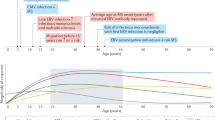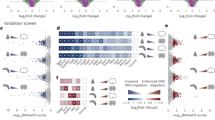Abstract
Multiple sclerosis (MS) is a complex chronic neurologic disease with a suspected autoimmune pathogenesis1,2. Although there is evidence that the development of MS is determined by both environmental influences and genes, these factors are largely undefined3,4, except for major histocompatibility (MHC) genes. Linkage analyses and association studies have shown that susceptibility to MS is associated with genes in the human histocompatibility leukocyte antigens (HLA) class II region, but the contribution of these genes to MS disease development is less compared with their contribution to disorders such as insulin-dependent diabetes mellitus5,6,7,8,9,10,11. Due to the strong linkage disequilibrium in the MHC class II region, it has not been possible to determine which gene(s) is responsible for the genetic predisposition12. In transgenic mice, we have expressed three human components involved in T-cell recognition of an MS-relevant autoantigen presented by the HLA-DR2 molecule: DRA*0101/DRB1*1501 (HLA-DR2), an MHC class II candidate MS susceptibility genes found in individuals of European descent; a T-cell receptor (TCR) from an MS-patient-derived T-cell clone specific for the HLA-DR2 bound immunodominant myelin basic protein (MBP) 84–102 peptide13,14; and the human CD4 coreceptor. The amino acid sequence of the MBP 84–102 peptide is the same in both human and mouse MBP. Following administration of the MBP peptide, together with adjuvant and pertussis toxin, transgenic mice developed focal CNS inflammation and demyelination that led to clinical manifestations and disease courses resembling those seen in MS. Spontaneous disease was observed in 4% of mice. When DR2 and TCR double-transgenic mice were backcrossed twice to Rag2 (for recombination-activating gene 2)-deficient mice, the incidence of spontaneous disease increased, demonstrating that T cells specific for the HLA-DR2 bound MBP peptide are sufficient and necessary for development of disease. Our study provides evidence that HLA-DR2 can mediate both induced and spontaneous disease resembling MS by presenting an MBP self-peptide to T cells.
This is a preview of subscription content, access via your institution
Access options
Subscribe to this journal
Receive 12 print issues and online access
$209.00 per year
only $17.42 per issue
Buy this article
- Purchase on Springer Link
- Instant access to full article PDF
Prices may be subject to local taxes which are calculated during checkout




Similar content being viewed by others
References
Steinman, L. Multiple sclerosis: a coordinated immunological attack against myelin in the central nervous system. Cell 85, 299– 302 (1996).
Noseworthy, J.H. Progress in determining the causes and treatment of multiple sclerosis. Nature 399, A40–47 ( 1999).
Ebers, G.C., Sadovnick, A.D. & Risch, N.J. A genetic basis for familial aggregation in multiple sclerosis. Canadian Collaborative Study Group. Nature 377, 150–151 (1995).
Ebers, G.C. & Dyment, D.A. Genetics of multiple sclerosis. Semin. Neurol. 18, 295– 299 (1998).
Coraddu, F. et al. HLA typing in the United Kingdom multiple sclerosis genome screen. Neurogenetics 2, 24– 33 (1998).
Olerup, O. & Hillert, J. HLA class II-associated genetic susceptibility in multiple sclerosis: a critical evaluation. Tissue Antigens 38, 1–15 ( 1991).
Haines, J.L. et al. Linkage of the MHC to familial multiple sclerosis suggests genetic heterogeneity. The Multiple Sclerosis Genetics Group. Hum. Mol. Genet. 7, 1229–1234 (1998).
Haines, J.L. et al. A complete genomic screen for multiple sclerosis underscores a role for the major histocompatibility complex. The Multiple Sclerosis Genetics Group. Nature Genet. 13, 469– 471 (1996).
Sawcer, S. et al. A genome screen in multiple sclerosis reveals susceptibility loci on chromosome 6p21 and 17q22. Nature Genet. 13 , 464–468 (1996).
Ebers, G.C. et al. A full genome search in multiple sclerosis. Nature Genet. 13, 472–476 ( 1996).
Kuokkanen, S. et al. Genomewide scan of multiple sclerosis in Finnish multiplex families. Am. J. Hum. Genet. 61, 1379– 1387 (1997).
Sawcer, S. & Goodfellow, P.N. Inheritance of susceptibility to multiple sclerosis. Curr. Opin. Immunol. 10, 697–703 (1998).
Wucherpfennig, K.W. et al. Clonal expansion and persistence of human T cells specific for an immunodominant myelin basic protein peptide. J. Immunol. 152, 5581–5592 ( 1994).
Wucherpfennig, K.W. et al. Structural requirements for binding of an immunodominant myelin basic protein peptide to DR2 isotypes and for its recognition by human T cell clones. J. Exp. Med. 179, 279– 290 (1994).
Kouskoff, V., Fehling, H.J., Lemeur, M., Benoist, C. & Mathis, D. A vector driving the expression of foreign cDNAs in the MHC class II positive cells of transgenic mice. J. Immunol. Methods 166, 287–291 (1993).
Fugger, L., Michie, S.A., Rulifson, I., Lock, C.B. & McDevitt, G.S. Expression of HLA-DR4 and human CD4 transgenes in mice determines the Vb T cell repertoire and mediates an HLA-DR restricted immune response. Proc. Natl Acad. Sci. USA 91, 6151–6155 (1994).
Kouskoff, V., Signorelli, K., Benoist, C. & Mathis, D. Cassette vectors directing expression of T cell receptor genes in transgenic mice. J. Immunol. Methods 180, 273– 280 (1995).
Olivares-Villagomez, D., Wang, Y. & Lafaille, J.J. Regulatory CD4+ T cells expressing endogenous T cell receptor chains protect myelin basic protein-specific transgenic mice from spontaneous autoimmune encephalomyelitis. J. Exp. Med. 188, 1883–1894 ( 1998).
Van de Keere, F. & Tonegawa, S. CD4+ T cells prevent spontaneous experimental autoimmune encephalomyelitis in anti-myelin basic protein T cell receptor transgenic mice. J. Exp. Med. 188, 1875–1882 (1998).
Goverman, J. et al. Transgenic mice that express a myelin basic protein-specific T cell receptor develop spontaneous autoimmunity. Cell 72, 551–560 (1993).
Fogdell, A., Hillert, J., Sachs, C. & Olerup, O. The multiple sclerosis- and narcolepsy-associated HLA class II haplotype includes the DRB5*0101 allele. Tissue Antigens 46, 333– 336 (1995).
Spurkland, A. et al. The HLA-DQ(α1*0102, β1*0602) heterodimer may confer susceptibility to multiple sclerosis in the absence of the HLA-DR(α 1*01, β1*1501) heterodimer. Tissue Antigens 50 , 15–22 (1997).
Pearson, C.I., van Ewijk, W. & McDevitt, H.O. Induction of apoptosis and T helper 2 (Th2) responses correlates with peptide affinity for the major histocompatibility complex in self-reactive T cell receptor transgenic mice. J. Exp. Med. 185, 583–599 ( 1997).
Goverman, J. Tolerance and autoimmunity in TCR transgenic mice specific for myelin basic protein. Immunol. Rev. 169, 147– 159 (1999).
Katz, J.D., Wang, B., Haskins, K., Benoist, C. & Mathis, D. Following a diabetogenic T cell from genesis through pathogenesis. Cell 74, 1089– 1100 (1993).
Fugger, L., Rothbard, J. & McDevitt, G.S. Specificity of an HLA-DRB1*0401 restricted T cell response to type II collagen. Eur. J. Immunol. 26, 928–933 (1996).
Killeen, N., Sawada, S. & Littman, D.R. Regulated expression of human CD4 rescues helper T cell development in mice lacking expression of endogenous CD4. EMBO J. 12, 1547–1553 ( 1993).
Jansson, L., Olsson, T., Hojeberg, B. & Holmdahl, R. Chronic experimental autoimmune encephalomyelitis induced by the 89-101 myelin basic protein peptide in B10RIII (H-2r) mice. Eur. J. Immunol. 21, 693–699 (1991).
Sundvall, M. et al. Identification of murine loci associated with susceptibility to chronic experimental autoimmune encephalomyelitis. Nature Genet. 10, 313–317 ( 1995).
Smith, K.J., Pyrdol, J., Gauthier, L., Wiley, D.C. & Wucherpfennig, K.W. Crystal structure of HLA-DR2 (DRA*0101, DRB1*1501) complexed with a peptide from human myelin basic protein. J. Exp. Med. 188, 1511–1520 ( 1998).
Acknowledgements
We thank D. Mathis and C. Benoist for providing vectors, discussions and for reading the manuscript; D. Littman for providing human CD4 transgenic mice; and M. Clark and M. Svejme for expertise and assistance in animal caretaking and immunohistopathology. This work was supported by grants from the Karen Elise Jensen Foundation of Denmark, the Swedish Medical Research Council, the European Union (BMH4-CT97-2522 and ERBBIO4CT960562), the National Multiple Sclerosis Society (USA), the NIH, the Danish Medical Research Council, the Novo Nordisk Foundation and the Danish Multiple Sclerosis Society.
Author information
Authors and Affiliations
Corresponding author
Rights and permissions
About this article
Cite this article
Madsen, L., Andersson, E., Jansson, L. et al. A humanized model for multiple sclerosis using HLA-DR2 and a human T-cell receptor. Nat Genet 23, 343–347 (1999). https://doi.org/10.1038/15525
Received:
Accepted:
Issue Date:
DOI: https://doi.org/10.1038/15525
This article is cited by
-
Non-mutational neoantigens in disease
Nature Immunology (2024)
-
Integrative systems and functional analyses reveal a role of dopaminergic signaling in myelin pathogenesis
Journal of Translational Medicine (2020)
-
ATX-MS-1467 Induces Long-Term Tolerance to Myelin Basic Protein in (DR2 × Ob1)F1 Mice by Induction of IL-10-Secreting iTregs
Neurology and Therapy (2018)
-
Identification of new susceptibility loci for type 2 diabetes and shared etiological pathways with coronary heart disease
Nature Genetics (2017)
-
Bee Venom Acupuncture Alleviates Experimental Autoimmune Encephalomyelitis by Upregulating Regulatory T Cells and Suppressing Th1 and Th17 Responses
Molecular Neurobiology (2016)



